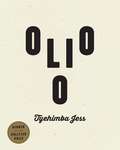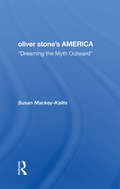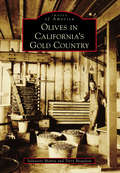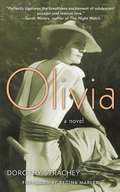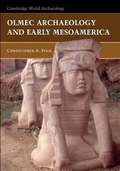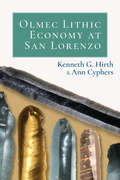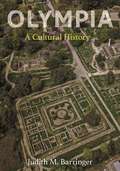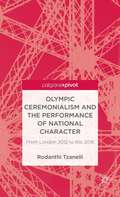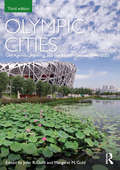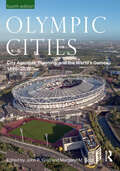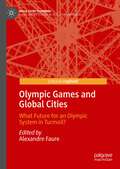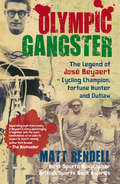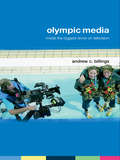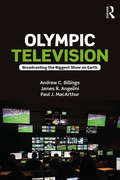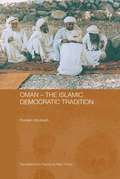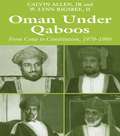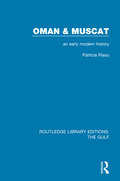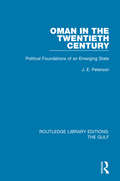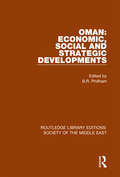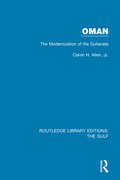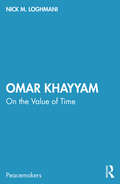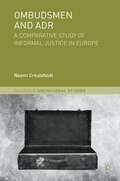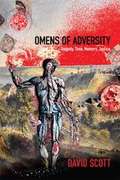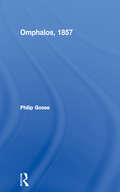- Table View
- List View
Olio
by Tyehimba JessWinner of the 2017 Pulitzer Prize in Poetry <p><p> Winner of the 2017 Anisfield-Wolf Book Award in Poetry <p> Winner of the 2017 Book Award from the Society of Midland Authors for Poetry <p> 2016 National Book Critics Circle Award finalist for poetry <p> 2017 PEN/Jean Stein Book Award finalist <p> 2017 Kingsley Tufts Poetry Award finalist <p> Named a top poetry book of spring 2016 by Library Journal <p> Part fact, part fiction, Tyehimba Jess's much anticipated second book weaves sonnet, song, and narrative to examine the lives of mostly unrecorded African American performers directly before and after the Civil War up to World War I. Olio is an effort to understand how they met, resisted, complicated, co-opted, and sometimes defeated attempts to minstrelize them.
Oliver Stone's America: dreaming The Myth Outward (Film Studies)
by Susan Mackey-kallis Susan Mackey KallisThis book represents an illustrated, critical analysis of filmmaker Oliver Stone and his works, placing him in the tradition of American political artists. Oliver Stone—polemicist, leftist, artist, and—surprisingly for politically conservative America—mainstream director—is one of the most controversial American filmmakers in Hollywood. His films i
Olives in California's Gold Country
by Salvatore Manna Terry BeaudoinThe history of the olive in the Gold Country of Northern California is a story of the Spanish in the New World, of the Gold Rush, of immigrants from Italy and other Mediterranean countries, of bold pioneers, enterprising farmers and scientists, and of businessmen and businesswomen. Focusing on Calaveras County in the south and Placer County in the north, but also exploring the olive throughout most of Northern California, including olive havens such as Corning and Oroville, that story is told within these pages through rare and fascinating photographs. For those who wish to explore the olive in Northern California, whether its history, industry or technology, this volume provides both an appetizer and a satisfying entrée. As love of the olive grows, for the first time a book tells the tale of the olive tree, the king of trees, in the Mother Lode of California.
Olivia
by Regina Marler Dorothy StracheyConsidered one of the most subtle and beautifully written lesbian novels of the century, this 1949 classic returns to print in a Cleis Press edition.Dorothy Strachey's classic Olivia captures the awakening passions of an English adolescent sent away for a year to a small finishing school outside Paris. The innocent but watchful Olivia develops an infatuation for her headmistress, Mlle. Julie, and through this screen of love observes the tense romance between Mlle. Julie and the other head of the school, Mlle. Cara, in its final months.Although not strictly autobiographical, Olivia draws on the author's experiences at finishing schools run by the charismatic Mlle. Marie Souvestre, whose influence lived on through former students like Natalie Barney and Eleanor Roosevelt. Olivia was dedicated to the memory of Strachey's friend Virginia Woolf and published to acclaim in 1949. Colette wrote the screenplay for the 1951 film adaptation of the novel. In 1999, Olivia was included on the Publishing Triangle's widely publicized list of the 100 Best Gay and Lesbian Novels of the 20th Century.
Olmec Archaeology and Early Mesoamerica
by Christopher A. PoolThe foundations for the Maya and other civilizations of ancient Mesoamerica were laid down over 2400 years ago during the early and middle phases of the Formative period. The most elaborate of these formative Mesoamerican societies are represented by the archaeological culture called Olmec, which merged some 3500 years ago in the tropical lowlands of southern Veracruz and Tabasco, Mexico. Flourishing over the next 1000 years, the Olmecs created the most complex social and political hierarchies of their time on the North American continent. Olmec rulers expressed their material and religious power in the first monumental stone art of Mesoamerica, remarkable for its sophistication and naturalism, as well as massive buried offerings of wealth obtained from great distances. Olmec Archaeology and Early Mesoamerica offers the most thorough and up-to-date book-length treatment of Olmec society and culture available.
Olmec Lithic Economy at San Lorenzo
by Kenneth Hirth Ann CyphersOlmec Lithic Economy at San Lorenzo examines the specialized craft production, manufacturing, adoption, and spread of obsidian cutting tools at San Lorenzo, Mexico, the first major Olmec center to develop in the southern Gulf Coast region of Mesoamerica. Through the systematic analysis of this single commodity, Kenneth Hirth and Ann Cyphers reconstruct the importation of raw material and the on-site production and distribution of finished goods from a specialized workshop engaged in the manufacture of obsidian blades. The obsidian blade was the cutting tool of choice across Mesoamerica and used in a wide range of activities, from domestic food preparation to institutional ritual activities. Hirth and Cyphers conducted a three-decade investigation of obsidian artifacts recovered at Puerto Malpica, the earliest known workshop, and seventy-six other sites on San Lorenzo Island, where these tools were manufactured for local and regional distribution. Evidence recovered from these excavations provides some of the first information on how early craft specialists operated and how the specialized technology used to manufacture obsidian blades spread across Mesoamerica. The authors use geochemical analyses to identify thirteen different sources for obsidian during San Lorenzo’s occupation. This volcanic glass, not locally available, was transported over great distances, arriving in nodular and finished blade form. Olmec Lithic Economy at San Lorenzo offers a new way to analyze the Preclassic lithic economy—the procurement, production, distribution, and consumption of flaked stone tools—and shows how the study of lithics aids in developing a comprehensive picture of the internal structure and operation of Olmec economy. The book will be significant for Mesoamericanists as well as students and scholars interested in economy, lithic technology, and early complex societies.
Olympia: A Cultural History
by Professor Judith M. BarringerA comprehensive and richly illustrated history of one of the most important athletic, religious, and political sites in the ancient Greek and Roman worldThe memory of ancient Olympia lives on in the form of the modern Olympic Games. But in the ancient era, Olympia was renowned for far more than its athletic contests. In Olympia, Judith Barringer provides a comprehensive and richly illustrated history of one of the most important sites in the ancient Greek and Roman world, where athletic competitions took place alongside—and were closely connected with—crucial religious and political activities.Barringer describes the development of the Altis, the most sacred area of Olympia, where monuments to athletes successful in the games joined those erected to the gods and battlefield victories. Rival city-states and rulers built monuments to establish eminence, tout alliances, and join this illustrious company in a rich intergenerational dialogue. The political importance of Olympia was matched by its place as the largest sanctuary dedicated to Zeus, king of the gods. Befitting Zeus’s role as god of warfare, the Olympian oracle was consulted to ensure good omens for war, and the athletic games embodied the fierce competition of battle. Other gods and heroes were worshipped at Olympia too, Hera, Artemis, and Herakles among them.Drawing on a comprehensive knowledge of the archaeological record, Barringer describes the full span of Olympia’s history, from the first monumental building around 600 BC to the site’s gradual eclipse in the late Christianized Roman empire. Extensively illustrated with maps and diagrams, Olympia brings the development of Olympia vividly to life for modern readers.
Olympic Ceremonialism and The Performance of National Character: From London 2012 to Rio 2016
by Rodanthi TzanelliThis book examines the London 2012 opening and closing ceremonies and the handover to Rio 2016 as articulations of national and cosmopolitan belonging. The ceremonial performances supported imaginative travel and created a tornadoros: an ideal form of 'human' that manipulates audiovisual narratives of culture and identity for global audiences.
Olympic Cities: City Agendas, Planning, and the World’s Games, 1896 – 2020
by John R. Gold Margaret M. GoldThe first edition of Olympic Cities, published in 2007, provided a pioneering overview of the changing relationship between cities and the modern Olympic Games. This substantially revised and enlarged third edition builds on the success of its predecessors. The first of its three parts provides overviews of the urban legacy of the four component Olympic festivals: the Summer Games; Winter Games; Cultural Olympiads; and the Paralympics. The second part comprisessystematic surveys of seven key aspects of activity involved in staging the Olympics: finance; place promotion; the creation of Olympic Villages; security; urban regeneration; tourism; and transport. The final part consists of nine chronologically arranged portraits of host cities, from 1936 to 2020, with particular emphasis on the six Summer Olympic and Paralympic Games of the twenty-first century. As controversy over the growing size and expense of the Olympics, with associated issues of accountability and legacy, continues unabated, this book’s incisive and timely assessment of the Games’ development and the complex agendas that host cities attach to the event will be essential reading for a wide audience. This will include not just urban and sports historians, urban geographers, event managers and planners, but also anyone with an interest in the staging of mega-events and concerned with building a better understanding of the relationship between cities, sport and culture.
Olympic Cities: City Agendas, Planning, and the World’s Games, 1896 – 2032 (ISSN)
by John R. Gold Margaret M. GoldThe first edition of Olympic Cities, published in 2007, provided a pioneering overview of the changing relationship between cities and the modern Olympic Games. This substantially revised and much enlarged fourth edition builds on the success of its predecessors. The first of its three parts provides overviews of the urban legacy of the four component Olympic festivals: the Summer Games; Winter Games; Cultural Olympiads; and the Paralympics. The second part comprises systematic surveys of six key aspects of activity involved in staging the Olympics and Paralympics: finance; sustainability; the creation of Olympic Villages; security; urban regeneration; and tourism. The final part consists of ten chronologically arranged portraits of host cities from 1960 to 2032, with complete coverage of the Summer Games of the twenty-first century.As controversy over the growing size and expense of the Olympics, with associated issues of democratic accountability and legacy, continues unabated, this book’s incisive and timely assessment of the Games’ development and the complex agendas that host cities attach to the event will be essential reading for a wide audience. This will include not just urban and sports historians, urban geographers, event managers, and city planners, but also anyone with an interest in the staging of mega-events and concerned with building a better understanding of the relationship between cities, sport, and culture.
Olympic Games and Global Cities: What Future for an Olympic System in Turmoil? (Mega Event Planning)
by Alexandre FaureThis book offers a comprehensive overview of current debates on the influence of the Olympic Games on cities, urban policies and the governance of global cities, making a valuable contribution to the fields of Olympic studies and urban studies. Historically, Western cities such as Paris, London, and later Los Angeles, have been the primary hosts of the summer Games. However, the link that existed between the world metropolises of the last century and the Games has deeply changed. Growing concerns about the Games' costs and environmental impact have prompted a shift in the expectations of candidate cities and the International Olympic Committee (IOC). This evolution favours more modest bids, and a resurgence of global cities and historical Olympic host cities within the Olympic landscape. This book is an essential resource for researchers in Olympic studies, urban studies, and all those involved in the planning of these events.
Olympic Gangster: The Legend of José Beyaert - Cycling Champion, Fortune Hunter and Outlaw
by Matt RendellRestlessly vital and possessed of great physical strength, José Beyaert lived many lives. During the Second World War, he boxed and trafficked arms for the Resistance on his bicycle. After it, he became an international cyclist. In 1948, a mile from the end of the Olympic road race around Windsor Park, he broke away alone to take the gold medal and started an adventure that would last the rest of his life. A Tour de France rider in the sport's golden age, José was invited to open a new velodrome in Colombia, South America. He travelled, intending to stay a month. Instead, driven by his thirst for adventure, he stayed for fifty years, becoming by turns athlete, coach, businessman, emerald-trader, logger, smuggler, perhaps even hired killer. Matt Rendell, who knew José Beyaert and met many of his family, friends and associates, tells the fascinating story of an almost-forgotten sporting hero who, incapable of living by other people's rules, lived his many lives on his own terms.
Olympic Media: Inside the Biggest Show on Television (Routledge Critical Studies in Sport)
by Andrew C BillingsLocated in the United States, NBC (National Broadcasting Company) is the biggest and most powerful Olympic network in the world, having won the rights to televise both the Summer and the Winter Olympic Games. By way of attracting more viewers of both sexes and all ages and ethnicities than any other sporting event, and through the production of breathtaking spectacles and absorbing stories, NBC’s Olympic telecasts have huge power and potential to shape viewer perceptions. Billings’s unique text examines the production, content, and potential effects of NBC’s Olympic telecasts. Interviews with key NBC Olympic producers and sportscasters (including NBC Universal Sports and Olympics President Dick Ebersol and primetime anchor Bob Costas) outline the inner workings of the NBC Olympic machine; content analyses from ten years of Olympic telecasts (1996-2006) examine the portrayal of nationality, gender, and ethnicity within NBC’s telecast; and survey analyses interrogate the extent to which NBC’s storytelling process affects viewer beliefs about identity issues. This mixed-method approach offers valuable insights into what Billings portrays as "the biggest show on television".
Olympic Television: Broadcasting the Biggest Show on Earth
by Andrew C. Billings James R. Angelini Paul J. MacArthurAs the Olympic spectacle grows, broadcast coverage becomes bigger, more complex, and more sophisticated. Part sporting event, part reality show, and part global festival, the Olympics can be seen as both intensely nationalistic and a celebration of a shared sense of international community. This book sheds new light on how the Olympic experience has been shaped by television and expanded across multiple platforms and formats. Combining a multitude of approaches ranging from interviews to content analyses to audience surveys, the book explores the production, influence, and significance of Olympic media in contemporary society. Built on a central case study of NBC’s coverage of the Rio Games in 2016, which is then placed within 20 years of content analyses, the book focuses on the entire Olympic television process from production to content to effects. Touching on key themes such as race, gender, history, consumerism, identity, nationalism, and storytelling, Olympic Television: Broadcasting the Biggest Show on Earth is fascinating reading for any student or scholar with an interest in sport, media, and the global impact of mega-events.
Oman - The Islamic Democratic Tradition (Durham Modern Middle East and Islamic World Series #Vol. 8)
by Hussein GhubashOman is the inheritor of a unique political tradition, the imama (imamate), and has a special place in the Arab Islamic world. From the eighth century and for more than a thousand years, the story of Oman was essentially a story of an original, minority, movement: the Ibadi. This long period was marked by the search for a just imama through the Ibadi model of the Islamic State. Hussein Ghubash’s well-researched book takes the reader on an historical voyage through geography, politics, and culture of the region, from the sixteenth century to the present day. Oman has long-standing ties with East Africa as well as Europe; the first contact between Oman and European imperialist powers took place at the dawn of the 1500s with the arrival of the Portuguese, eventually followed by the Dutch, French and British. Persuasive, thorough and drawing on Western as well as Islamic political theory, this book analyzes the different historical and geopolitical roles of this strategic country. Thanks to its millennial tradition, Oman enjoys a solid national culture and a stable socio-political situation. Today, it is moving steadily towards a democratic future.
Oman Under Qaboos: From Coup to Constitution, 1970-1996
by Calvin H. Allen W. Lynn Rigsbee IIThis is an examination of the political, economic and social development of Oman from the accession Sultan Qaboos in a palace coup in 1970 to the promulation of the basic law of 1996. The book argues that the sultanate does not follow the "rentier" model but the patriarchal tradition.
Oman and Muscat: An Early Modern History (Routledge Library Editions: The Gulf #12)
by Patricia RissoDuring the early modern period Oman held a key position in the trade routes whereby the Muslim world dominated indigenous trade in the Indian Ocean. In the second half of the eighteenth century, Oman broke free from foreign political control and became the dominant economic and naval force in the western Indian Ocean and the Gulf. This was a golden age for Omanis, when their economic power and political prestige were at their height. This study, first published in 1986, presents a detailed, comprehensive history of this important period, and includes tribal politics, the role of religion, and Oman’s relations with neighbouring areas such as Persia and East Africa. The era ends with the political and maritime pressures exerted on Oman by Britain and France, and the territorial pressures exerted by the Wahhabi Arabians.
Oman in the Twentieth Century: Political Foundations of an Emerging State (Routledge Library Editions: The Gulf #13)
by J.E. PetersonOman was ruled by the Al Bu Sa’id for 250 years, and during this period the fortunes of the state varied considerably. But in July 1970, as a result of a palace coup, the state abruptly turned away from isolation and traditions of the past. The most obvious alteration was in the dramatic change in the outward appearance of the country, particularly as exemplified by the rejection of the long era of stagnation and the parallel emphasis on socio-economic development. In the political realm, however, the shifting balance of power and the rapid growth and diversification of the state’s administrative structure were based essentially on perennial themes in Omani politics. The interplay between four of these themes forms the basis of this study, first published in 1978. The role of the Sultan and the ruling family, the development of the administration, the exercise of tribal politics and the impact of external influences on the state are closely examined and the modifications they went in response to the various challenges of the twentieth century are discussed. The constant flux in the relative importance of each of these themes illustrates the fragile nature of the traditional Omani political system, for in the twentieth century the Al Bu Sa’id Sultanate found its precarious hold over the country challenged on a number of occasions. These challenges – ranging from the tribal and religious rebellion of 1913-20, to the Marxist-Leninist revolt in Dhufar – are also analysed in detail, together with the response of the Sultanate to their impact.
Oman: Economic, Social and Strategic Developments (Routledge Library Editions: Society Of The Middle East Ser.)
by B. R. PridhamOman is an important country for the West, both as an oil exporter and as a key ally strategically placed at the entrance to the Gulf. This book, first published in 1987, provides an overview of post-war social, political and economic developments in the country. It outlines the historical and geographical background, considers economic developments both in the oil and non-oil sectors, as well as exploring societal changes in Omani culture and education.
Oman: The Modernization Of The Sultanate (Routledge Library Editions: The Gulf)
by Calvin H. Allen, JrUntil the 1970s Oman was an isolated, almost medieval kingdom, virtually unknown to the outside world. The 1970 palace coup that brought Sultan Qaboos b. Sa’id Al-Sa’id to power also brought Oman into the twentieth century. Development programmes made modernization a rapid process, and Oman’s location at the entrance to the Straits of Hormuz gave the country an increasing importance to US security interests in the Gulf region. Yet despite modernization, Oman remains an unknown land. This book, first published in 1987, dispels some of the mystery by focusing on the land, the people and the history. It explores the influences on events of trade, foreign involvement in Omani affairs, and Ibadism (the principal sect of Islam in Oman). It also emphasizes the role of the Sultan in contemporary Oman. The architect of Oman’s ‘new age’, Qaboos has overseen significant changes in the country’s political system and rapid economic growth financed by oil exports.
Omar Khayyam: On the Value of Time (Peacemakers)
by Nick M. LoghmaniThis book explores the life and work of Omar Khayyam as a provocateur of peace. While Khayyam is known for his poetry, he was foremost a prominent mathematician who looked at the world from a unique perspective. Using the transformative power of mathematics, he brought together seemingly irreconcilable concepts in his work. Through his art, philosophy, and mathematics, Khayyam sought to create harmony between what on the surface looks like a clash between his scientific view, romantic and often provocative poetry, and philosophy. The book sheds light on his spiritual and philosophical journey through a cross-sectional account of his poetry, philosophical view, and mathematics and science. It explores the complex inner life of a multidimensional scholar as he negotiated between faith and science, constructing a framework for peace by looking at the world as it presents itself to us, contemplating the temporality of life and enriching it with wisdom and joy. Historically and culturally informed, this book will be indispensable to readers of Omar Khayyam’s poetry and philosophy. It will also be of interest to students and researchers of peace and conflict studies, mathematics, science, Middle East literature, history, and popular culture.
Ombudsmen and ADR: A Comparative Study Of Informal Justice In Europe (Palgrave Socio-Legal Studies)
by Naomi CreutzfeldtHow do ordinary people experience and make sense of the informal justice system? Drawing on original data with British and German users of Ombudsmen— an important institution of informal justice, Naomi Creutzfeldt offers a nuanced comparative answer to this question. In so doing, she takes current debates on procedural justice and legal consciousness forward. This book explores consciousness around ‘alternatives’ to formal legality and asks how situated assumptions about law and fairness guide people's understandings of the informal justice system. Creutzfeldt shows that the everyday relationship that people have with the informal justice system is shaped by their experiences and expectations of the formal legal system and its agents. This book is an innovative theoretical and empirical statement about the future prospects for informal justice in Europe.
Omens of Adversity: Tragedy, Time, Memory, Justice
by David ScottOmens of Adversity is a profound critique of the experience of postcolonial, postsocialist temporality. The case study at its core is the demise of the Grenada Revolution (1979-1983), and the repercussions of its collapse. In the Anglophone Caribbean, the Grenada Revolution represented both the possibility of a break from colonial and neocolonial oppression, and hope for egalitarian change and social and political justice. The Revolution's collapse in 1983 was devastating to a revolutionary generation. In hindsight, its demise signaled the end of an era of revolutionary socialist possibility. Omens of Adversity is not a history of the Revolution or its fallout. Instead, by examining related texts and phenomena, David Scott engages with broader, enduring issues of political action and tragedy, generations and memory, liberalism and transitional justice, and the possibility of forgiveness. Ultimately, Scott argues that the palpable sense of the neoliberal present as time stalled, without hope for emancipatory futures, has had far-reaching effects on how we think about the nature of political action and justice.
Omnipresencia del miedo
by Jean DelumeauLa historia del miedo en Occidente. En este ensayo, Jean Delumeau (El miedo en Occidente, Taurus) explora los principales miedos que han marcado la civilización occidental desde la Antigüedad. A través de frases hechas, ritos y la literatura, el autor examina algunos de los terrores más recurrentes. El mar, por ejemplo, se convirtió en el lugar del miedo y en símbolo de locura. La cultura occidental ha estado siempre influida por el terror a lo lejano y a lo próximo, a lo nuevo y a lo viejo. En definitiva, a todo aquello que no se podía entender. «Antiguamente el miedo estaba en todas partes.»
Omphalos, 1857: An Attempt To Untie The Geological Knot
by Philip GosseGosse argued that fossils are not really the remains of creatures which existed. God had created the world in six days, but had made it look like it was already ancient, complete with the remains of non-existent pre-historic life. Gosse's work was popular with neither Christians nor evolutionists.
